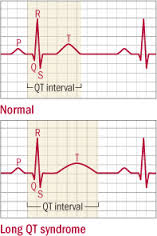
Long QT syndrome is a potentially fatal heart arrhythmia that’s usually diagnosed in childhood.
Cardiac arrest may occur at any unpredictable time, but there are at least two signs that are predictive if a teenager with long QT syndrome will suffer cardiac arrest.
Two of these signs are:
• Fainting during childhood
• Puberty
Blood pressure drugs can reduce the risk of cardiac arrest by 64 percent.
This information comes from a study published in the Journal of the American Medical Association.
What Is Long QT Syndrome?
“Certain forms of long QT syndromes can also present with seizures — and sometimes cardiac arrest can be the first and only presentation,” says Dr. Pezad Doctor, MD, a pediatric cardiology Fellow with UT Southwestern Medical Center/Children’s Health.
“The age of presentations can vary from a few months to a few decades.”
• The genetic version is rare, accounting for around a thousand fatal cardiac arrests every year in the U.S., the total being 330,000.
• The QT interval is that segment of time during which the heart’s lower chambers “repolarize” to prepare for the next beat.
• An EKG shows the QT interval.

• The term “long” refers to the extra length of time for the repolarization.
• This extra time is measured in milliseconds.
• Because of the prolongation preceding the repolarization, the patient is at risk for cardiac arrest.
• Children and teens with LQTS may seem perfectly normal until an event triggers fainting or cardiac arrest.
• The event may be physical exertion, sudden loud noise or highly charged emotions – tripping up the heart’s electrical system.
LQTS explains why some seemingly healthy teenagers suddenly drop during sports practice or competition and die.
How is LQTS detected?
“There are a few ways that children are detected with this condition,” says Dr. Doctor.
“Most often there is either a family member with the diagnosis of long QT syndrome that leads to further testing, or, a child gets an electrocardiogram for some other reason and is diagnosed incidentally.”
“In some cases, children live without any symptoms until developing sudden cardiac arrest in adulthood.
“It’s also important to note that all children who faint don’t necessarily have Long QT syndrome and therefore, it’s important to seek medical advice from a licensed medical provider.”
The JAMA Study
• Researchers looked at 2,772 patients from the LQTS Registry who were alive at age 10 and monitored by a doctor till 20.
• The team wanted to learn which risk factors were linked only with cardiac arrest in teens (fatal and not fatal).
• Three predictors were unveiled: 1) prior fainting episodes, 2) length of QT interval prolongation, and 3) gender.
Fainting
It was found that the participants who’d had at least two fainting episodes in the two years preceding the study period were 18 times more likely to suffer a cardiac arrest than were kids with zero history of fainting in the previous 10 years.
Kids who had only one fainting spell in the prior two years had 12 times the risk.
Kids who’d been on high blood pressure drugs for two years prior to the start of the study had a 64 percent lower risk of cardiac arrest.
“However, the likelihood of having long QT syndrome in a teenager who faints is very very low — as the overall incidence of fainting in this population due to other non-cardiac benign conditions is very high,” says Dr. Doctor.
“We see many kids in the cardiology clinic with fainting, but long QTc is very rarely detected due to overall low prevalence in the population.”
Dr. Doctor points out that in kids and teens, the more likely causes of fainting include postural syncope (rising up too quickly causing a blood pressure drop), low blood sugar and heat stroke.
“They surely need to seek medical consultation to differentiate between these benign causes vs. long QTc.”
QTc Prolongation
The QTc means that the interval is corrected for individual heart rate during the EKG.
A QTc equal to or exceeding 530 milliseconds meant a doubled risk of cardiac arrest compared to shorter QTcs.
Gender
Between age 10 and 12, boys had a four times greater risk.
Between 13 and 20 there was no significant difference in risk.
This is believed to be due to hormonal differences.
There are seven types of long QT syndrome.
The study did not show a link between any one type and the risk of cardiac arrest.
Long QT syndrome can also be caused by anorexia nervosa or “energy” drinks.



























